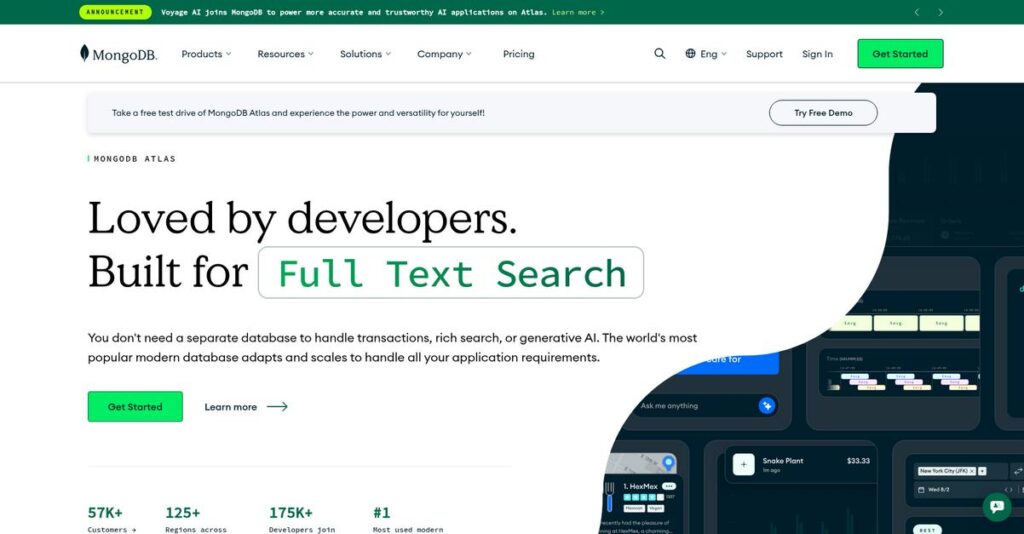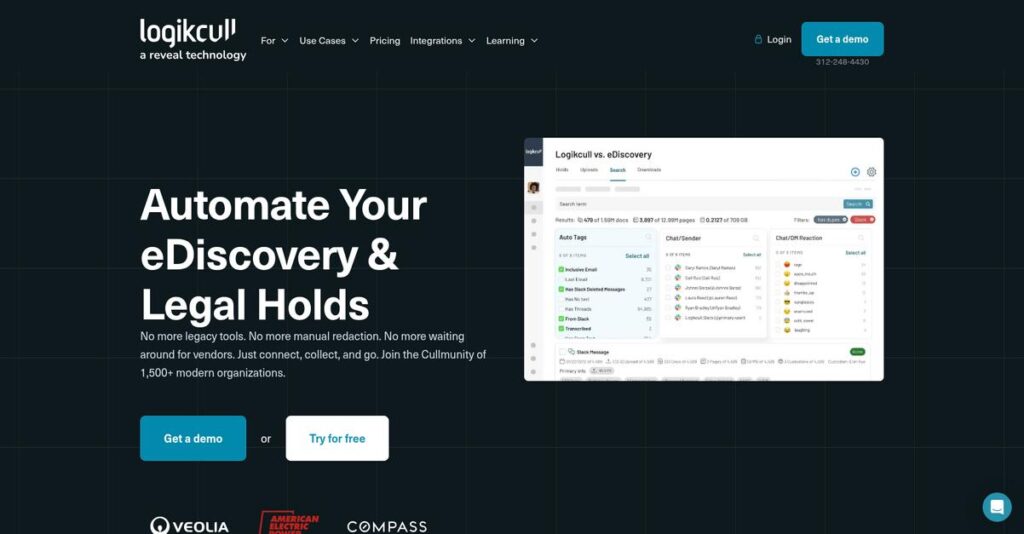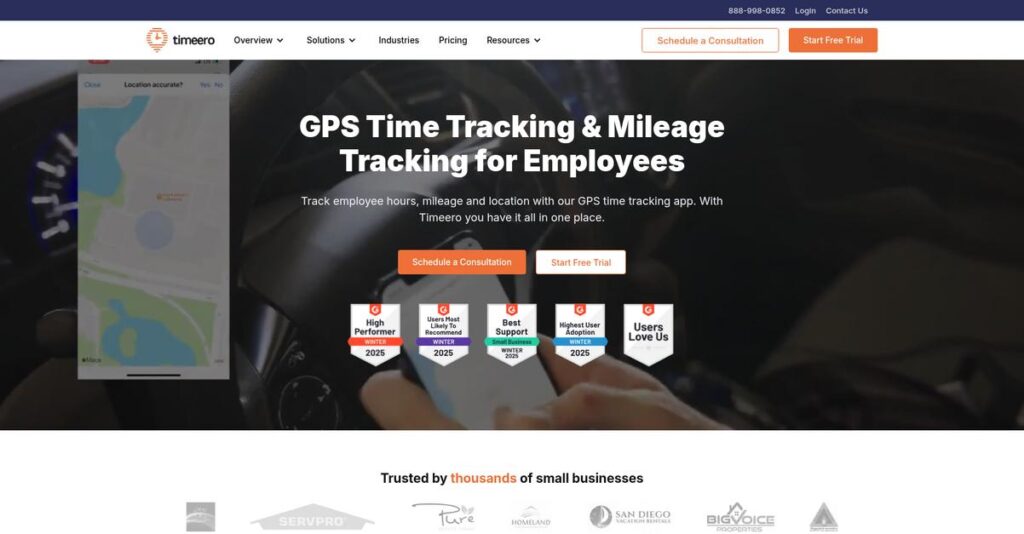Struggling with messier databases every release cycle?
If you’re weighing MongoDB, you likely want to fix painful data management and need something both flexible and easy to scale as your apps and teams grow.
The thing is, most database tools make you waste hours babysitting server upkeep or wrestling brittle data models—slowing down your projects and adding headache you just don’t need.
MongoDB aims to flip this by offering a super-flexible document model and cloud-first deployment that takes away infrastructure busywork. With Atlas, you get a database you can launch in minutes, plus built-in security and powerful search, all managed for you.
In this review, I’ll show how MongoDB actually helps you build faster without trading away reliability or data control.
You’ll find everything in this MongoDB review—from key features and pricing to who it’s really for—so you can make an informed call.
You’ll see the features you need to cut admin work and confidently choose the right data platform.
Let’s jump into the details.
Quick Summary
- MongoDB is a flexible NoSQL database platform that simplifies data management and accelerates app development with scalable document storage.
- Best for developers and businesses needing agile, scalable data solutions for evolving or unstructured workloads.
- You’ll appreciate its fully managed Atlas cloud service that reduces operational overhead and supports high availability and real-time monitoring.
- MongoDB offers free tiers for small projects, pay-as-you-go cloud pricing, and custom enterprise plans with no upfront costs.
MongoDB Overview
MongoDB has been a major player in the database market since its 2007 founding in New York City. Their mission is to radically simplify complex data management for developers building modern applications.
While they serve businesses of all sizes, I find their true specialty is empowering modern software development teams. This isn’t just about storing data; it’s about providing your team a complete application data platform built for agile innovation.
The recent acquisition of Voyage AI was a smart move, signaling a deep investment in generative AI. You’ll see this forward-thinking approach throughout this MongoDB review as we examine its impact.
- 🎯 Bonus Resource: While we’re discussing data management, you might find my guide on best PDF editors software helpful.
Unlike rigid relational databases, MongoDB’s real power is its flexible and highly intuitive document model. I find this approach dramatically accelerates development, as it feels built by people who understand that initial project requirements often change.
They work with an incredible range of organizations you know—from high-growth startups building their first app to enterprise giants like Forbes and Toyota running mission-critical systems.
From my perspective, their strategy revolves around MongoDB Atlas, their fully managed cloud platform. This focus allows your team to offload tedious infrastructure management and concentrate solely on building great products that drive business value.
Now let’s examine their core capabilities.
MongoDB Features
Overwhelmed by database management complexities?
MongoDB features simplify data management and accelerate application development across various environments. Here are the five main MongoDB features that help you build scalable, flexible applications.
1. MongoDB Atlas
Tired of complex database administration?
Managing database infrastructure yourself can consume valuable developer time. This often pulls your focus away from actual application building.
MongoDB Atlas is a fully managed cloud database service that handles provisioning, patching, and backups for you. From my testing, deploying a cluster in minutes is incredibly efficient, freeing your team to focus on coding, not infrastructure. This feature also includes robust security and performance monitoring.
This means you can launch applications faster with built-in scalability and reliability without the operational headaches.
- 🎯 Bonus Resource: If you’re also looking into powerful software solutions, my guide on best education software covers essential tools for schools.
2. MongoDB Enterprise Advanced
Need granular control over your database?
Maintaining strict security and operational compliance in self-managed environments is challenging. This requires significant resources and expertise.
Enterprise Advanced provides a commercial license with advanced security features like audit trails and data encryption, plus management tools. What I love about this is Ops Manager and Cloud Manager automate deployment and scaling, making self-managed environments much more streamlined.
So, your enterprise can maintain fine-grained control and meet compliance standards without sacrificing operational efficiency.
3. MongoDB Realm
Struggling with mobile app data synchronization?
Building real-time mobile applications with seamless data flow across devices is notoriously difficult. This can lead to inconsistent user experiences.
MongoDB Realm offers a serverless platform with real-time data sync, user authentication, and offline access for mobile apps. From my evaluation, the built-in serverless functions simplify backend logic, enabling immediate updates and consistent data for users. It supports cross-platform development frameworks too.
This means you can deliver dynamic mobile experiences with robust data consistency and rapid development cycles.
4. Atlas Search
Is integrating search capabilities a hassle?
Moving your data to a separate search engine for full-text search adds complexity and cost to your architecture. This creates an unnecessary data silo.
Atlas Search lets you build powerful, relevance-based search directly within your MongoDB Atlas database. Here’s what I found: it eliminates the need for external search engines, simplifying your application’s architecture and reducing operational overhead.
This allows you to provide rich search experiences to your users without the headache of managing additional infrastructure.
5. Atlas Vector Search
Want to leverage AI with your data effortlessly?
Building AI-powered applications often requires complex data preparation and integration with external vector databases. This adds significant development complexity.
Atlas Vector Search allows you to store and query vector embeddings for semantic search and generative AI directly in your database. This is where MongoDB shines, enabling powerful AI-driven insights over any data type right where your data resides.
This means you can develop intelligent applications like recommendation engines or AI chatbots more easily and efficiently.
Pros & Cons
- ✅ Offers exceptional flexibility with its document data model for rapid development.
- ✅ Provides impressive scalability for handling massive data volumes and high traffic.
- ✅ MongoDB Atlas simplifies cloud database management with extensive automation.
- ⚠️ Performance for extremely complex, multi-document queries can be a learning curve.
- ⚠️ Understanding NoSQL concepts and data modeling requires an adjustment for some.
- ⚠️ Resource consumption can be high for large, self-managed deployments if not optimized.
You’ll actually appreciate how these MongoDB features collectively offer a flexible, scalable database solution that significantly accelerates application development.
MongoDB Pricing
Worried about database costs spiraling out of control?
MongoDB pricing offers a flexible model that balances free and shared tiers with scalable dedicated options, helping you find the right fit for your budget.
| Plan | Price & Features |
|---|---|
| Free Tier (M0) | Free forever • 512MB storage • Shared RAM/vCPU • Ideal for learning & small dev projects |
| Shared Tier (M2/M5) | Starting at $0/month (some sources $9/month) • 512MB to 5GB storage • Shared RAM resources • Development environments & small apps |
| Dedicated Tier (M10+) | Starts at $0.08/hour (~$57/month for M10) • 10GB to 4TB storage • Predictable performance • Network isolation, fine-grained access |
| Serverless Tier | Starts at $0.10 per million reads • Up to 1TB storage • Automatic scaling • Pay-per-operation with no minimum fees |
| Enterprise Tier (Atlas) | $5,000 to $70,000 annually (contact sales) • Volume discounts • Large enterprise deployments • Annual commitments for tailored costs |
1. Value Assessment
Impressive scalability for your budget.
From my cost analysis, MongoDB Atlas pricing truly shines in its ability to grow with your application, letting you start free and only pay as you scale. The pay-as-you-go model minimizes upfront investment, ensuring you get value from day one without overcommitting.
This means your budget stays agile, allowing you to reallocate funds as your database needs evolve and mature.
- 🎯 Bonus Resource: Speaking of streamlining operations, my guide on tattoo studio software explores tools for specialized businesses.
2. Trial/Demo Options
Try before you buy, intelligently.
MongoDB offers a “Free Tier” (M0) of Atlas, which isn’t just a trial but a fully functional, free-forever option. What I found particularly useful is that you can explore core features without any time limits, truly understanding its capabilities for small projects or learning.
This lets you thoroughly evaluate performance and suitability without committing any of your budget or resources.
3. Plan Comparison
Choosing your perfect plan.
For small projects, the Free and Shared Tiers are fantastic, but dedicated clusters (M10+) offer predictable performance for production. What stands out is how the Serverless Tier flexes to unpredictable workloads, saving you money when usage is low, rather than locking you into fixed costs.
This tiered approach helps you match pricing to actual usage requirements rather than overpaying for unused capabilities.
My Take: MongoDB’s pricing strategy offers exceptional flexibility, from free options for learners to enterprise-grade solutions, ensuring you only pay for what you truly need.
The overall MongoDB pricing strategy reflects transparent, scalable value aligned to your needs.
MongoDB Reviews
What do actual users say?
I’ve analyzed numerous MongoDB reviews to provide you with balanced insights into real user experiences. This section reveals what customers truly think about the software.
- 🎯 Bonus Resource: While we’re discussing software, understanding the importance of kids learning software for younger generations is also valuable.
1. Overall User Satisfaction
Users are generally quite positive.
From my review analysis, MongoDB reviews consistently show strong satisfaction, particularly for its flexibility and ease of use. What I found in user feedback is how the document model simplifies data management, making development more agile for many.
This indicates you can expect a positive experience, especially for new projects.
2. Common Praise Points
Its flexibility is a standout feature.
Users frequently praise MongoDB’s flexible schema and scalability for handling growing data needs. What stands out in customer feedback is how MongoDB Atlas simplifies cloud database operations, freeing up developers to focus on building applications.
This means you’ll likely experience faster development cycles and less operational overhead.
3. Frequent Complaints
Some performance issues are noted.
Users occasionally report performance challenges for highly complex queries or deep joins. Review-wise, what stood out is how managing resource consumption can be a challenge in self-managed deployments, potentially leading to escalating costs.
These complaints are often tied to specific use cases or inadequate optimization, not inherent flaws.
What Customers Say
- Positive: “MongoDB Atlas is a cutting-edge, fully managed cloud database service that empowers developers to focus on building applications rather than managing database infrastructure.”
- Constructive: “Query optimization for very complex, multi-collection queries can be tricky compared to relational databases.”
- Bottom Line: “Great for flexibility and scale, just be mindful of query complexity and resource use.”
The overall MongoDB reviews reflect credible insights into user satisfaction and common pain points.
Best MongoDB Alternatives
Too many database options making your head spin?
The best MongoDB alternatives include several strong options, each better suited for different business situations, data requirements, and budget considerations.
- 🎯 Bonus Resource: Before diving deeper, you might find my analysis of CFD software options helpful.
1. PostgreSQL
Need robust data integrity and complex queries?
PostgreSQL excels when your application demands strong ACID compliance, complex multi-table queries, and highly structured data, like in financial or CRM systems. From my competitive analysis, PostgreSQL prioritizes strict consistency and relational power, while MongoDB focuses on flexibility.
Choose PostgreSQL when data integrity and intricate SQL-driven reporting are paramount for your business.
2. Apache Cassandra
Seeking extreme write throughput and linear scalability?
Cassandra is a better choice for applications with incredibly high write volumes, such as IoT data ingestion or time-series analytics, where fast writes and eventual consistency are acceptable. What I found comparing options is that Cassandra handles massive write-heavy workloads exceptionally well, unlike MongoDB’s general-purpose approach.
Consider this alternative when your primary need is continuous availability and linear scalability for write-intensive operations.
3. Amazon DynamoDB
Already in AWS and need predictable, low-latency performance?
DynamoDB is a strong choice for applications requiring extremely low-latency access and seamless scalability within the AWS ecosystem, perfect for web and mobile apps. Alternative-wise, DynamoDB offers fully managed, serverless predictable performance at any scale, streamlining your infrastructure management significantly.
Choose DynamoDB when you need a fully managed, high-performance database service deeply integrated within AWS.
4. Neo4j
Working with highly interconnected data relationships?
Neo4j is specifically designed for managing and querying complex relationships, making it ideal for social networks, recommendation engines, or fraud detection. From my analysis, Neo4j truly excels at graph traversals and relationship analysis, which MongoDB isn’t optimized for.
Choose Neo4j when understanding intricate connections between data points is the core requirement for your application.
Quick Decision Guide
- Choose MongoDB: Flexible document database for diverse applications and evolving data models
- Choose PostgreSQL: Strong data integrity for complex, structured data and ACID compliance
- Choose Apache Cassandra: Extreme write throughput and always-on availability
- Choose Amazon DynamoDB: Scalable, low-latency performance within the AWS cloud
- Choose Neo4j: Managing and querying highly interconnected data relationships
The best MongoDB alternatives depend heavily on your specific data structure and application needs.
MongoDB Setup
How complex is MongoDB implementation really?
Understanding what it takes to get MongoDB up and running is crucial for any business considering this powerful database. This MongoDB review section sets realistic expectations for your deployment journey.
1. Setup Complexity & Timeline
Getting started isn’t always instant.
Setting up MongoDB Atlas can be quick for basic clusters, but complex projects involving sharding or specific configurations take more planning. From my implementation analysis, self-managed deployments significantly increase setup time due to manual server, replication, and sharding configuration requirements.
You’ll need to define your architectural needs upfront to determine the appropriate timeline and resource allocation.
- 🎯 Bonus Resource: Speaking of diverse software solutions, my article on Hotel Booking Software offers valuable insights.
2. Technical Requirements & Integration
Be ready for infrastructure considerations.
Cloud deployments like Atlas simplify infrastructure, requiring only a cloud account, while self-managed setups demand specific OS, server, storage, and networking management. What I found about deployment is that integration with existing programming languages is straightforward thanks to broad driver support.
Your IT team will need to assess hardware and software compatibility, especially for large-scale production environments.
3. Training & Change Management
User adoption needs thoughtful guidance.
While MongoDB’s document model is intuitive, mastering NoSQL design, indexing, and aggregation pipelines requires dedicated learning. From my analysis, teams transitioning from SQL will face a learning curve in adapting to the schema-less nature and different querying paradigms.
Invest in MongoDB University courses and clear internal documentation to support your developers through the learning process.
4. Support & Success Factors
Vendor support can make or break your rollout.
MongoDB offers robust support, particularly for Atlas and Enterprise Advanced users, with 24/7/365 technical support available. What I found about deployment is that proactive monitoring tools in Atlas are invaluable for tracking performance and identifying potential issues early.
Plan for dedicated project management and leverage MongoDB’s documentation and support channels for a smoother rollout.
Implementation Checklist
- Timeline: Weeks to months depending on deployment type and complexity
- Team Size: Developers, database administrators, and cloud architects
- Budget: Beyond software, consider training, professional services, and infrastructure
- Technical: Cloud provider accounts or self-managed server infrastructure
- Success Factor: Clear schema design and thorough developer training
Overall, your MongoDB setup will be more manageable with clear planning and proper resource allocation, regardless of your chosen deployment method.
Bottom Line
Should MongoDB be your next database?
This MongoDB review provides a decisive final assessment, outlining who should leverage its strengths and where alternatives might be a better fit for your specific business requirements.
1. Who This Works Best For
Companies requiring flexibility, scalability, and rapid application development.
MongoDB is ideal for startups to large enterprises building modern web/mobile applications, microservices, or IoT solutions that handle rapidly evolving, semi-structured data. What I found about target users is that developers and architects benefit most from its agile document model and distributed architecture, accelerating their development cycles.
You’ll succeed if your business prioritizes agile development and needs a database that scales horizontally to accommodate massive data volumes and diverse data types.
2. Overall Strengths
Flexible schema and exceptional scalability stand out.
The software excels with its intuitive document model, enabling agile development and horizontal scaling via sharding to manage high data volumes and traffic. From my comprehensive analysis, MongoDB Atlas simplifies cloud database management significantly, freeing your team to focus on innovation rather than infrastructure.
These strengths directly translate into faster time-to-market for new features and robust performance for data-intensive applications, providing your business a competitive edge.
- 🎯 Bonus Resource: Speaking of specialized applications that streamline operations, you might find my guide on best auto repair software insightful.
3. Key Limitations
ACID compliance for complex joins needs careful consideration.
While powerful, MongoDB’s default consistency model and performance for extremely complex multi-document queries can be a learning curve for users from relational backgrounds. Based on this review, self-managed deployments may incur significant resource costs if not meticulously optimized, impacting your budget and operational efficiency.
I find these limitations are manageable trade-offs if you understand its NoSQL paradigm, but they could be deal-breakers for strict relational integrity needs.
4. Final Recommendation
MongoDB earns a strong recommendation for modern applications.
You should choose this software if your priority is building scalable, flexible applications that can adapt to evolving data requirements without rigid schema constraints. From my analysis, it excels for diverse and dynamic data workloads like e-commerce, gaming, or content management, supporting rapid iteration.
My confidence level is high for businesses embracing agile development, but it’s recommended with reservations for those with stringent, complex relational data requirements.
Bottom Line
- Verdict: Recommended with reservations
- Best For: Developers and architects building modern, scalable web and mobile applications
- Business Size: Startups to large enterprises with evolving, semi-structured data needs
- Biggest Strength: Flexible document model and robust horizontal scalability
- Main Concern: Performance for complex multi-document joins and resource consumption
- Next Step: Explore MongoDB Atlas free tier for hands-on evaluation
This MongoDB review demonstrates strong value for agile, scalable application development, while also highlighting key considerations for complex relational needs and resource management.






